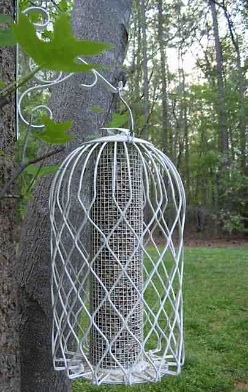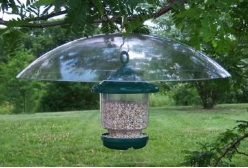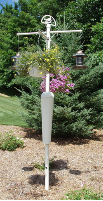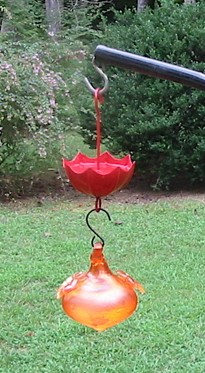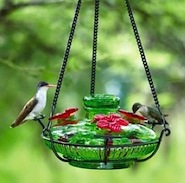-
How to Squirrel Proof Bird Feeders that Work!
Birds seem ravenous this time of year, feeders are being emptied at record rates, so nobody needs squirrels swiping seed! Partly due to the fall migration, and partly because resident birds know winter is coming soon. As daylight hours become shorter, birds flying south must fuel up for their long journeys, while many residents will simply cache seeds and nuts for future meals later in the season. Nuthatches and jays are famous for this practice.
Many folks think squirrel proof bird feeders just don’t work, while others are bummed because the popular Squirrel-Away powder is no longer available. It’s amazing how many non-believers there are; from face-to-face discussions at a recent show, to customers from our website, they just don’t believe anything will deter their superman-like squirrels from feeders!
Ah… but there are ways, and it’s mostly about placement of the feeders themselves and using baffles! One secret is the “horizontal launching point”. If squirrels can jump sideways from anything to gain feeder access, chances are they will – no, it’s guaranteed they will!
When placed correctly, baffles turn any feeders into squirrel-proof feeders. Be it hanging, pole mounted, or post mounted… they absolutely work at foiling the critters!
For hanging feeders, the baffle circumference must be a good bit larger than the feeder itself – at least 1/3 larger. A 20-inch clear acrylic baffle works great, we use them in our yard. The bottom of this feeder should be no less than 4.5 feet from the ground. Lastly, it must hang at least 8 feet away from a tree trunk, pole, or anything else a
squirrel might jump sideways from to gain access.
For pole or post mounted feeders, again be sure the bottom of the feeder is at least 4.5 to 5 feet from the ground. Remember the horizontal launch point – anything squirrels might jump from sideways to gain access. One other consideration is a potentially taller launch spot; anything the critters might jump down from to get to the feeder. A lot of thought for just one feeder? Maybe so, but well worth the effort!
Say you have a a fancy shepherd’s hook that no baffle will fit over on either end? Not a problem with an innovative locking baffle that opens for fast installation.
Some pole systems have built-in baffles that are excellent at thwarting squirrels. The Squirrel Stopper is one such system. It’s received fantastic
reviews because of sturdy construction, durability and good looks! Hang up to eight feeders, baths or even flower baskets from this gem!
It’s a matter of “if you build it – they won’t come”. By putting some careful planning in place, you can squirrel proof any type of bird feeder against pesky squirrels!
-
Instant Window Bird Feeders – Even Window Bird Baths!
They say the kitchen is the heart of the home, with meals, conversation and most comings and goings through the door leading to the garage where vehicles are parked. Builders know it’s the sink where much time is spent and usually place a window above it for natural light, views of trees (if you’re lucky) and lush green yards.
Placing window bird feeders within this view is an optimal spot for catching the great outdoors and nature’s happenings without interrupting daily routines. If by chance the deck is off your kitchen or breakfast room, its rails are absolutely perfect for the birds! The feeder need not necessarily mount on the window itself!
A really cool and versatile bracket thing called a deck ring lets you add an instant feeder, or even a bird bath in
seconds. It clamps on with simple hardware (no tools required) and best of all there’s no damage to rails. The sturdy iron ring will accommodate heavier ceramic bowls, as simple plant saucers are perfect for feeders or baths. Say you don’t want any mess that birdseed can bring? Opt for fresh water- it’s by far the easiest and best way to entice feathered friends! Add a heater to that bowl in winter and the activity promises to mesmerize… it’ll be the most popular spot in the yard.
With close-up views like these, you’ll see birds from another perspective. Right now many are looking a little sickly with streaked plumage that’s half dull and half bright. But it’s just the molting process that happens every fall. Birds are shedding old, tattered feathers for new ones to help them through another season of cooler weather.
Entice more feathered friends to your place and liven up the view from that kitchen sink quickly and easily by placing a feeder or bath right on the deck rail.
-
The Ever Important Ant Moat
“Every day, every single day I’m changing the nectar because of ants” my friend said in desperation. Insisting if she’d just use an ant moat, the problem would be solved. She kept saying her feeder had one, to which I replied “then keep it filled”. When she told me “you can’t” – I then insisted “then something’s upside down!”
How frustrating because it’s a fairly simple principle… ants won’t cross water because they never took swimming lessons. Gathering two moats and a new glass hummingbird feeder she had her eye on, it was time to see the moat that couldn’t be filled, it piqued my curiosity.
Upon seeing the cheap plastic feeder (it’s okay, we use them sometimes too) it was absolutely moat-less. “There’s no moat, that’s why the ants keep getting to it”. I showed her the little cup-shape moat, said to fill it with water and hang the hummingbird feeder directly below.
It was like a light went off, and a clear understanding was now obvious. Why would we even mention it? Because everyone starts somewhere when feeding the birds. When you’ve been doing it for 30 years or so, much knowledge is gained as to what works and what doesn’t. The hobby’s become wildly popular in the past few years, which means there’s a lot of folks who are fairly new to backyard birding.
Everyone loves hummingbirds, they’re one of summers’ highlights, but ants can ruin the experience quickly… for the tiny sprites too! It takes just one pesky ant to sour a feeder full of fresh nectar – and that’s a bummer. They must emit something terribly fowl to hummingbirds?
Save your nectar and your money by using a moat and making your own sugar-water solution. It’s SO easy and really fast, no red dye needed. Table sugar and water at a 1:4 ratio… that’s it! No other ingredients as they’re harmful to the birds. During migration, the nectar can be a bit stronger at 1:3, the extra calories serve the birds well for their long journey ahead.
Oh yeah, and the pretty glass feeder was an instant hit with her hummingbirds, she said it took about four seconds before they discovered it and started feeding!

